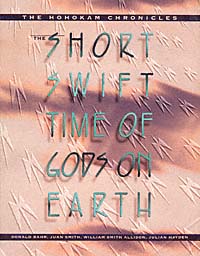It's been estimated in this book The Hohokam Chronicles that the last Hohokam period ended some 600 years ago in the 1400's. Some of what we know is written by a white archeologist Julian Hayden from text given in this book. It is a full, traditional Pima Indian creation narrative composed of thirty-six distinct stories that begin with the creation of the universe and end with the establishment of present-day villages. Versions of most of these stories have been published before, sometimes in isolation and sometimes as parts of larger texts. This text, in addition to having an interesting version of nearly every known Pima story, is the most complete natively-articulated set of such stories to be written to date - 1994.
According to the book, "The text was given because Hayden was interested in what the Pimas knew about the culture that he and his colleagues were investigating, a culture whose archaeological name, the Hohokam, was borrowed from Pima mythology."
What culture was Julian Hayden interested in? The so-called 'pre-historic' culture that is an amazing in-the-ground testimony of man-made engineering skills to build irrigation canals here in The Salt Valley.
_________________________________________________________________________
Reference: University of California Press
_________________________________________________________________________
The word means "Finished-ones" in Pima, but it was not clear to archaeologists or to white students of modern Pima culture exactly how this old culture had ended and what its relation was to the Pimas who had lived on former Hohokam territory since they were discovered and named "Pima" by the Spaniards around 1550.
It was hoped that the Smith-Allison text, taken down at a village built on a Hohokam site, would be of assistance.
Preferred Citation: Bahr, Donald, Juan Smith, William Smith Allison, and Julian Hayden. The Short, Swift Time of Gods on Earth: The Hohokam Chronicles.
Berkeley: University of California Press, c1994 1994. http://ark.cdlib.org/ark:/13030/ft5z09p0dh/
 |
| Map 2. Hohokam canals in the Salt River Valley. Granite Reef Dam is in the extreme northeast corner. (Drawn by Frank Midvale, a Phoenix archaeologist) |
What culture was Julian Hayden interested in? The so-called 'pre-historic' culture that is an amazing in-the-ground testimony of man-made engineering skills to build irrigation canals here in The Salt Valley.
_________________________________________________________________________
Reference: University of California Press
_________________________________________________________________________
The word means "Finished-ones" in Pima, but it was not clear to archaeologists or to white students of modern Pima culture exactly how this old culture had ended and what its relation was to the Pimas who had lived on former Hohokam territory since they were discovered and named "Pima" by the Spaniards around 1550.
It was hoped that the Smith-Allison text, taken down at a village built on a Hohokam site, would be of assistance.
In fact, the text was of no more help than others that were already known. It states maddeningly that the Pimas were both the same as and different from the Hohokam . . .
< see this accompanying map for geographic place names
BLOGGER NOTE: A substantial part of Southeast Arizona was named by The Spanish "Pimeria Alta". There is more documentation and written history on that area than what is available [or know] here in The Salt River Valley. Areas of Marana, just north of Tucson and areas in Patagonia, just 18 miles north of the transnational border with Mexico, have been studied more extensively than what we know. Here in Mesa there is Mesa Grande Cultural Center on Brown Road - readers of this blog can use the search blog for more information.
< see this accompanying map for geographic place names
BLOGGER NOTE: A substantial part of Southeast Arizona was named by The Spanish "Pimeria Alta". There is more documentation and written history on that area than what is available [or know] here in The Salt River Valley. Areas of Marana, just north of Tucson and areas in Patagonia, just 18 miles north of the transnational border with Mexico, have been studied more extensively than what we know. Here in Mesa there is Mesa Grande Cultural Center on Brown Road - readers of this blog can use the search blog for more information.
_______________________________________________________________
 |
The Short, Swift Time of Gods on Earth
The Hohokam ChroniclesDonald Bahr Juan Smith William Smith Allison Julian Hayden UNIVERSITY OF CALIFORNIA PRESS Berkeley · Los Angeles · Oxford © 1994 The Regents of the University of California |
Preferred Citation: Bahr, Donald, Juan Smith, William Smith Allison, and Julian Hayden. The Short, Swift Time of Gods on Earth: The Hohokam Chronicles.
Berkeley: University of California Press, c1994 1994. http://ark.cdlib.org/ark:/13030/ft5z09p0dh/
Introduction
The text given in this book is a full, traditional Pima Indian creation narrative composed of thirty-six distinct stories that begin with the creation of the universe and end with the establishment of present-day villages. Versions of most of these stories have been published before, sometimes in isolation and sometimes as parts of larger texts. This text, in addition to having an interesting version of nearly every known Pima story, is the most complete natively articulated set of such stories to be written to date. They were selected, narrated, intermittently commented on, and translated by two Pimas, Juan Smith and William Allison, over several nights in spring 1935 at Snaketown, a village on the Gila River Indian Reservation in Arizona.
Smith spoke in Pima, and Allison provided an English translation with comments. The estimated that the last Hohokam period ended in the 1400s. He took down the English with care to preserve Allison's diction and phrasing.
Snaketown was the site of an ongoing archaeological excavation.



